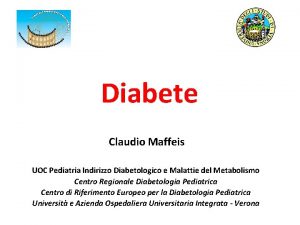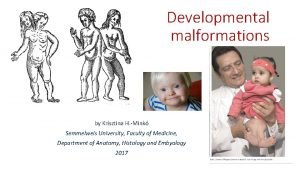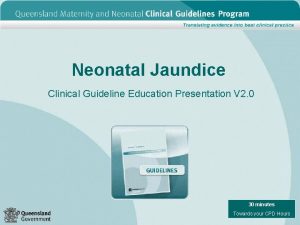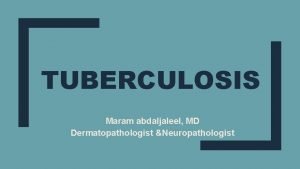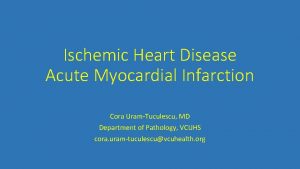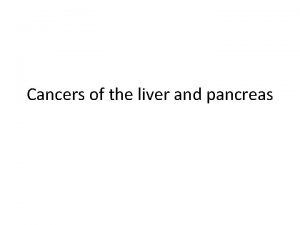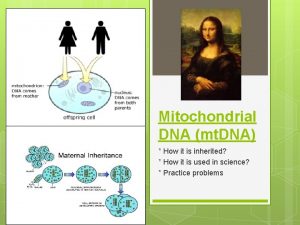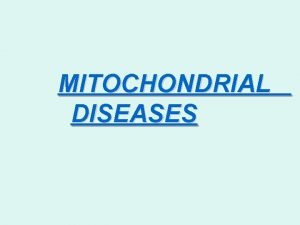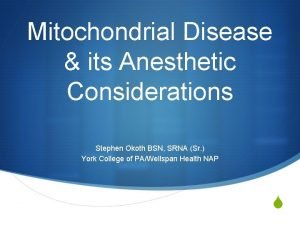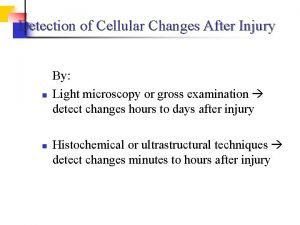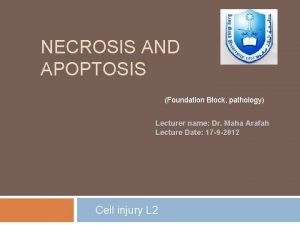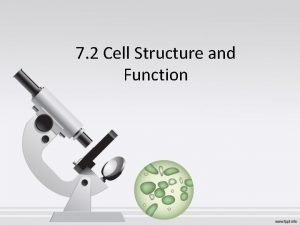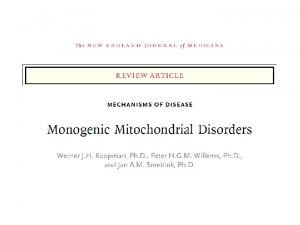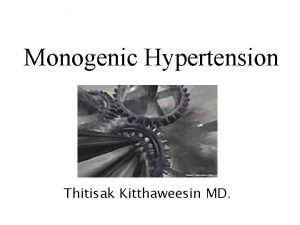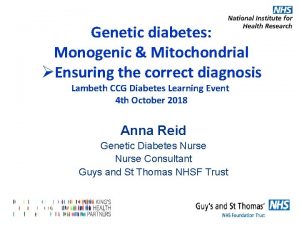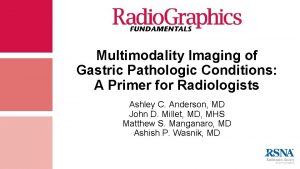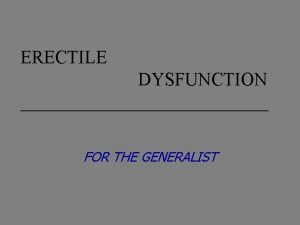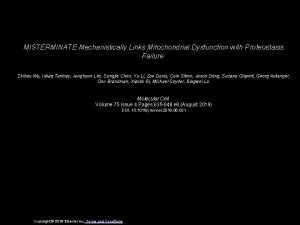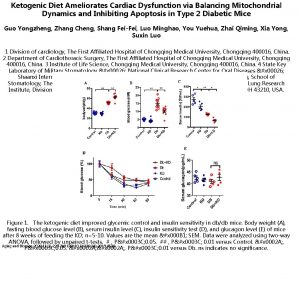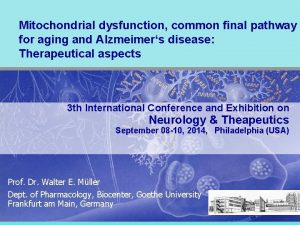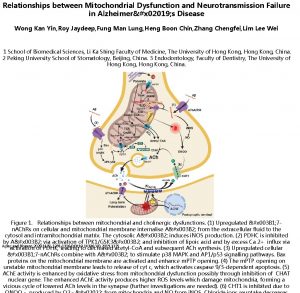Mitochondrial dysfunction Monogenic mitochondrial disorders Pathologic conditions such




















- Slides: 20


Mitochondrial dysfunction • Monogenic mitochondrial disorders • Pathologic conditions such as: – Alzheimer’s disease – Parkinson’s disease – Huntington’s disease – cancer – diabetes – obesity – epilepsy – cardiac disease • Progressive decline in the expression of mitochondrial genes is a central feature of normal human aging – It is not entirely clear whether these changes in expression have positive of negative effect on life span

Mitochondrial dysfunction – additional sources • off target effects of environmental toxins (e. g. rotenon) • frequently used drugs (e. g. statins, amiodarone , antipsychotic drugs, valproic acid-epilepsy, zidovudine- HIV treatment) • antibiotics • aspirin • chemotherapeutic agents (e. g. doxorubicin)

Monogenic mitochondrial diseases has considerably advanced our understanding of the cellular pathophysiology of mitochondrial dysfunction This review summarizes these insights and explain how they can contribute to the rational design of intervention strategies for mitochondrial dysfunction

Structure • Mitochondrial internal and external structure varies with – cell type – metabolic state – and often becomes altered during mitochondrial dysfunction Mutation in NDUFS 2 – Complex I

Structure The inner membrane contains many matrix- protruding folds (cristae) that increase the surface area of the inner membrane and have a dynamic structure. These structural dynamics may serve to regulate mitochondrial metabolism

Function Best known – production of ATP But also metabolite exchange, ion transport, protein import, production of reactive oxygen species, apoptosis

Monogenic cell models of mitochondrial dysfunction With the use of mitochondrial proteome analysis ~1000 genes encoding mitochondrial proteins were discovered in humans (Pagliarini, Cell 2008) Mitochondrial dusfunction can arise from a mutation in one of these genes – primary mitochondrial disorder or from an outside influence on mitochondria - secondary mitochondrial disorder (e. g. drugs)

Mutations in 228 protein-encoding n. DNA genes and 13 mt. DNA genes have been linked to a human disorder Renal cell cancer Diabetes Epilepsy Cancer of colon, Alzheimer’s disease, Complex I deficiency

Mutations and phenotypes • It is not clear how specific genetic defects are linked to dysfunction at the level of cells, organs, and the whole organism • It is difficult to determine the effects of specific defects because of compensatory stress–response pathways: – Mitochondrial biogenesis – Increased expression of oxidative phosphorylation proteins – A switch to a more glycolytic mode of ATP production – Removal of dysfunctional mitochondria by quality-control systems – The substrate supply, the mode of ATP generation, the level of demand for ATP, mitochondrial dynamics, rate of oxidative phosphorylation differ among cell types and tissue types cellular level Various types of tissues are not equally sensitive to mitochondrial dysfunction Genetic background also modifies the phenotype of human mitochondrial diseases. Manifested only when a certain threshold of Organism level mitochondrial dysfunction or cellular demand on mitochondrial metabolism is exceeded

Developing a rational intervention strategy • The functional properties of isolated mitochondria differ considerably from those within the cell • Mitochondrial function can also be investigated in intact (patient) cells

Developing a rational intervention strategy In a primary mitochondrial disorder, the mutation - affects the expression level of protein, its function, or both - induces primary cell consequences and secondary cell consequences: reduced ATP production increases in the cellular levels of mitochondrial proteins and mitochondrial function upregulation of the detoxification of reactive oxygen species It appears that primary and secondary mitochondrial disorders have similar consequences at the cellular level


Developing a rational intervention strategy Four intervention strategies for mitochondrial dysfunction have been described: – Genetic therapy- carried out at the preclinical level, mainly on mt. DNA- associated disorders (not included in the review) aim to: – Small molecules to target mitochondrial dysfunction 1. Increase ATP synthesis 2. Bypass the – Metabolic manipulation mitochondrial defect – Diet and exercise 3. Stimulate mitochondrial biogenesis ? 4. Reduce levels of ROS can act as signaling molecules, and therefore, their elimination might also have detrimental effects

Small molecules • Specific targeting of mitochondria by small molecules (referred to as “cargo”) can be achieved by • Protein-based cargo can be coupled to a mitochondrial targeting sequence recognized by the mitochondrial protein import machinery • Coupling the cargo to a delocalized lipophilic cation, leading to its accumulation in mitochondria (Several antioxidants have been successfully targeted using the cation approach such as Co. Q variant ) • Mitochondria-penetrating peptides are engineered cell-penetrating peptides that target mitochondria on the basis of their membrane potential and lipophilicity • Vesicle-based transporters that target mitochondria through macropinocytosis, endosomal escape, and membrane fusion

Intervention strategies for mitochondrial disease


Treatment • • • In 2006 – large scale review of published clinical trials of treatments for primary mitochondrial disorders revealed no evidence supporting the use of any intervention Several recent trials in which a variety of treatments for mitochondrial disease were studied, including dichloroacetate, vitamins, and a cocktail of specific food components showed a positive effect Co. Q 10 variant (idebenone)- was approved for the treatment of Friedreich’s ataxia (iron) A ketogenic diet was effective in preventing epileptic seizures in children with electron-transport-chain defects - suggesting that it may be worthwhile to pursue nutritional treatment strategies Ullrich’s congenital muscular dystrophy and Bethlem’s myopathy are associated with mitochondrial dysfunction and muscle-cell apoptosis (inappropriate opening of the mitochondrial permeability transition pore) prevented in patients treated with a permeability transition- pore desensitizer, cyclosporin A

Future perspectives • A field that began more than 50 years ago, when a physician detected a mitochondrial disorder in a single patient with hypermetabolism, has now evolved into the discipline of mitochondrial medicine • Lessons learned from studies of rare diseases have implications for a broad range of medical disciplines • Within the next few years, the application of new technologies (e. g. whole -exome sequencing) will result in a huge expansion of the number of known causative nuclear gene defects in patients with mitochondrial diseases • The challenge - to increase our understanding of the consequences of mitochondrial dysfunction at all levels of complexity in order to drive the development of rational treatment strategies • Direct enzyme-replacement therapy may be feasible in addressingleprotein enzymes, such as those in the tricarboxylic acid cycle

Future perspectives • Given the metabolic individuality in humans, we do not expect monotherapeutic metabolic manipulation strategies to be a magic bullet but predict that the next step in treatment development will be the use of combinations of manipulation strategies applied in an individualized way • In the meantime, efforts must be made on a global scale to genetically categorize patient cohorts, monitor them in a standardized way by means of prognostic scoring systems, and develop new biomarkers to allow for proper monitoring of the effect of intervention strategies
 Claudio maffeis
Claudio maffeis Turricephalus
Turricephalus Jaundice chart 37 weeks
Jaundice chart 37 weeks Robbins and cotran pathologic basis of disease
Robbins and cotran pathologic basis of disease Mother russia bleeds soundtrack
Mother russia bleeds soundtrack Pathologic jaundice
Pathologic jaundice Pathologic disease
Pathologic disease Bhutani normogram
Bhutani normogram Pathologic jaundice
Pathologic jaundice Pathologic
Pathologic Nursing diagnosis for neonatal jaundice
Nursing diagnosis for neonatal jaundice Pathologic q wave
Pathologic q wave Robbins and cotran pathologic basis of disease
Robbins and cotran pathologic basis of disease Mitochondrial dna
Mitochondrial dna Pearson syndrome
Pearson syndrome Labelled diagram of mitochondria class 9
Labelled diagram of mitochondria class 9 Mitochondrial swelling
Mitochondrial swelling Mitochondrial swelling
Mitochondrial swelling Tahapannya
Tahapannya Are ribosomes in chloroplasts
Are ribosomes in chloroplasts Zink common compensatory pattern
Zink common compensatory pattern
